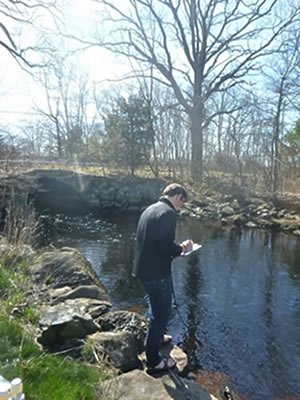Using Phylogenetics for Fecal Source Tracking in the SNEP Region
October 2020
The Palmer River begins in Rehoboth, Massachusetts in a mainly forested area before flowing alongside agricultural operations as it meanders its way south to the Rhode Island state border and eventually into the Barrington-Warren River and Narragansett Bay. While the Palmer River Watershed is fairly bucolic and agrarian, it, like many other watersheds in our region, is facing the ever-increasing pressure of suburbanization. But with agriculture and suburbanization comes pollution. In 1992 the Rhode Island Department of Environmental Management (RIDEM) listed portions of the river as impaired for recreation and shellfish consumption due to high levels of fecal coliform; the Massachusetts Department of Environmental Protection (MassDEP) followed suit in 2002. Shellfish beds were closed, and recreational activities were restricted for safety. The source of the fecal contamination was thought to be from crops, cattle and dairy farms, failing or illicitly connected septic systems, and waterfowl.

To begin lessening the fecal contamination coming from farms, the Palmer River watershed was included in the National Water Quality Initiative (NWQI) in 2012. Being an NWQI watershed makes Natural Resources Conservation Service (NRCS) project funding and expertise available and can often lead to opportunities for other sources of funding such as Clean Water Act (CWA) section 319 nonpoint source management funds. The funding typically goes to on-the-farm agricultural conservation practices, or best management practices (BMPs) as they are sometimes referred, that decrease the amount of pollution entering our waters while often increasing agricultural efficiency. In the Palmer River watershed, practices included creating grass buffers along waterways, improved litter and manure storage, livestock exclusion fences, and protecting heavy use areas from erosion, to name a few.
To understand how these practices were improving the water quality of the Palmer River, MassDEP, RIDEM, and the U.S Environmental Protection Agency (EPA) New England Regional Lab collaborated to collect traditional water samples between 2012 and 2019. As part of this monitoring effort, samples were collected from 2017-2019 for a novel analysis to determine specific sources of fecal contamination using the "PhyloChip" (Developed by Lawrence Berkley National Labs).
Applying this technique to ambient water samples tells you about its bacterial community composition which can then be compared to those normally found in the gut of various animals and humans. This comparison, in turn, gives us an idea of who or what has been contaminating the water with their feces. Traditional water quality sampling for e. coli, fecal coliform bacteria, and Enterococci, while extremely useful, can only indicate the potential that harmful fecal bacteria are present; whereas the PhyloChip can not only determine likely fecal contamination, but its mammalian source as well. It can also be used to determine if specific known, harmful species of bacteria are present.
The Southeast New England Program (SNEP) used 50 of the samples collected in 2018 in the Palmer River to conduct a pilot study using the PhyloChip. Samples were selected based on spatial and temporal representativeness, and their likelihood of fecal contamination. These results can be used to tell us which fecal source(s) is polluting the water segment. We learned that while cow, pig, pet, and horse contamination was present, human and waterfowl contamination occurred more often in more locations. The results indicate that farm-based contamination may not contribute as heavily to water quality impairment and shellfish bed closure as failing septic systems and Canadian geese (read the full report here). SNEP in conjunction with EPA's New England Regional Lab is currently working to analyze another set of Palmer River samples from 2019 to get an idea of contamination source changes over a longer time scale.
The results from this pilot, as well as others being conducted by EPA Region 1, are beginning to show the utility of this advanced, innovative, technique for tracking the sources, as well as spatial and temporal distribution, of fecal contamination in watersheds. Future studies may also include evaluation of the "sinks" of fecal contamination such aquaculture operations and shellfish beds.
For more information please contact: Ian Dombroski ([email protected]).
